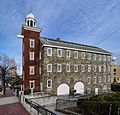Slater Mill facts for kids
|
Old Slater Mill
|
|
 |
|
| Location | Roosevelt Avenue, Pawtucket, Rhode Island |
|---|---|
| Area | 4.23 acres (1.71 ha) |
| Built | 1793 |
| NRHP reference No. | 66000001 |
Quick facts for kids Significant dates |
|
| Added to NRHP | November 13, 1966 |
| Designated NHL | November 13, 1966 |
The Slater Mill is a very important historical factory in Pawtucket, Rhode Island. It sits right on the Blackstone River. This mill was the first in America to use water power to spin cotton. It used a special system developed by Richard Arkwright in England.
The mill's founder, Samuel Slater, learned about factories in England. After moving to the United States, he was hired by Moses Brown. His job was to build machines that could spin cotton yarn using water power. The machines and the mill were finished in 1793. A dam and waterwheel were also built to power everything.
The factory used Arkwright's system for spinning cotton. This system included machines for carding, drawing, and spinning cotton. Samuel Slater first hired children and families to work in his mill. This way of hiring became known as the "Rhode Island System." It was used in many factories across the Blackstone Valley.
Later, a different system, the Waltham System, became more popular. The Slater Mill was also a place where workers first stood up for their rights. In 1824, young women workers led the first factory strike in the United States. They were asking for better working conditions.
The Slater Mill became a National Historic Landmark on November 13, 1966. It was also added to the National Register of Historic Places on the same day. In December 2014, the mill became part of the new Blackstone River Valley National Historical Park.
Building History: How the Mill Changed
The original Slater Mill, built in 1793, was a two-story building. It had six sections, called bays. Over the years, more parts were added to the mill. The first addition was in 1801, and another in 1835. A very large section was added to the north side between 1869 and 1872.
Cotton spinning continued at the mill until 1895. By then, most cotton production had moved to the southern United States. After 1895, the mill was used for different kinds of industrial work. The building had several fires over time. Two fires in 1912 made people realize how important it was to save the historic building.
From Factory to Museum
In 1921, a group called the Old Slater Mill Association was formed. Their goal was to save this important historical mill. Work to restore the mill began in 1923. They removed newer parts of the building. This made the mill look like it did in 1835. In 1955, it opened its doors as a museum.
The nearby Wilkinson Mill was built between 1810 and 1811. It was also restored in 1978. Today, it is part of the Slater Mill site.
The Slater Mill site is now a museum and an educational center. It also hosts music events. It celebrates new ideas and the spirit of starting businesses. It helps people learn about history, culture, and art. The site covers five acres of land along the Blackstone River. It includes a dam, the Slater Mill, the Wilkinson Mill, and the Sylvanus Brown House. The Sylvanus Brown House was built in 1758. It was moved to the mill site in the 1960s.
In 2021, the National Park Service took over the Slater Mill and other key buildings. They are now part of a new national park.
-
A spinning mule in Slater Mill
See also
- Blackstone River Valley National Heritage Corridor
- David Wilkinson
- Derwent Valley Mills
- Hannah Slater
- List of National Historic Landmarks in Rhode Island
- National Register of Historic Places listings in Pawtucket, Rhode Island
- Samuel Slater







